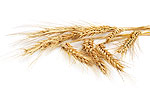 Getting lots of whole grains is a mainstay in the best health advice. They are the grains brimming with nutrients, they turn foods into food cures, and they keep your body in perfect working order. Here are the unofficial top five whole grains for your health.
Getting lots of whole grains is a mainstay in the best health advice. They are the grains brimming with nutrients, they turn foods into food cures, and they keep your body in perfect working order. Here are the unofficial top five whole grains for your health.
1. Spelt
This grain edges out the fiber-heavy barley for the number one spot, because it has a higher proportion of more nutrients, including more than your daily requirement of vitamin B2 in just two ounces of grain. This historical grain can be found in cereals, baked goods, crackers, and breads. You can also find it in the form of grain, flakes or flour. Its range of nutrients includes high amounts of vitamin B3, B1, manganese, and tryptophan. Two ounces of spelt will fill you with 20% of your daily requirements of fiber.
2. Barley
This old cereal is extremely nutritious and leads this food group in fiber. One cup gives you nearly 70% of your daily needs. Along with fiber’s great abilities in the body, barley’s fiber has a few special roles. It produces “butyric acid,” a fat that is the major energy source for cells in your intestines. It also produces “propionic acid,” which has been proven to lower cholesterol. Barley is high in “betaglucan,” which helps lower cholesterol. Barley is also overflowing with the antioxidant mineral selenium, and includes very high amounts of tryptophan, phosphorus, copper, and vitamin B3. Add barley bits to soups and stews, or find cereals and baked goods with barley.
3. Bulgur
Bulgur is cracked, parboiled wheat grains, best known as the central ingredient in tabouli. Bulgur is packed with nutrients, and its fiber content — at over 40% of your daily needs — is second only to barley. It is very high in manganese, tryptophan, magnesium and iron, and is a good source of three B-vitamins. Meanwhile, the calorie count on one cup of cooked bulgur wheat is just 151. Substitute it for rice for a big nutritional punch.
It is believed to help defend the body against –
- Digestive problems
- Cancer
- Heart disease
- Metabolic syndrome
- High blood pressure, and cholesterol.
4. Oats
When hulled, oats don’t lose their nutrients and fiber. They, too, contain beta-glucan to help lower cholesterol and oats pack phytochemicals in their little shelled bodies. Flavonoids in oats are the subject of new studies and appear to help prevent heart conditions. One cup of oats has excellent amounts of manganese and selenium in it, and offers very high amounts of phosphorus, tryptophan, vitamin B1, magnesium, and fiber (20%). It will also net you a good helping of protein and iron.
5. Brown Rice
Superior to white rice, brown rice is filled with extremely high levels of manganese, and high amounts of magnesium, phosphorus, B-vitamins, tryptophan, and fiber. Manganese helps to break down fatty acids and obtains energy from protein and carbohydrates. It is also a critical part of an enzyme in every cell that defends the body against free radicals. White rice is lacking most B-vitamins, half the iron, and all the fiber and health fats. For the highest nutrition, find brown basmati rice.
